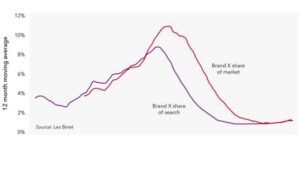Are you curious of how your sales and market share will develop during the coming years? There is a very simple recipe to secure growth, and a similar simple analysis tool available to predict your future position. So, why don’t use Share-of-Search to put the highlight on your market position today and in the future?
One of the most basic principles of marketing is that it takes investment to grow. The key metrics are your market share, Share-of-Market (SOM), relative to your share of communication in the category defined as Share-of-Voice (SOV).
Simply put, research has shown that if your SOV is greater than your SOM your market share increases over time. Conversely, if your SOM is greater than your SOV, there is a high risk that you will lose market shares to your competitors.
This simple equation should be well known for all marketers – and great news for their management teams and boards. All you must do is plug in some simple numbers about your communications budget and your company’s market share, and you can see what your expectations should be for revenue and growth the coming years.
However, there is a small problem. As we now put over 70% of our total media investment into digital channels, it is increasingly difficult to get a relevant view of the total media investment in a category. The reason is that there is simply no aggregated information on how much different companies are investing in digital channels.
But there is readily available data that gives us good guidance on how to manage our efforts and budgets. The solution is called SOS, or Share-of-Search, which is the brand’s share of Google searches compared with searches for competitors’ brands.
It is proven that investment in media is reflected in the search volume for the brand in question. There is also a clear correlation between a brand’s market share and the brand’s share of Google searches. These two correlations mean that if we track the evolution of SOS over time and relate that evolution to our communication efforts and market share, we have a tool to help us interpret how our market share will develop.
If SOS is higher than SOM, there is a good chance that we will grow. And conversely, if SOS is lower than SOM, there is a great risk that we will lose market share. This analysis model should therefore be a natural part of all ongoing market monitoring and planning.

Curious how your Share-of-Search looks compared with competitors? It’s simple to do an analysis, just reach out to ulf.vanselius@comprend.com
If you have missed any of the earlier insights, you will find them all on www.sfinxconsulting.se/blog
